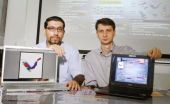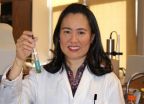(Press-News.org) Johns Hopkins Children's Center scientists have discovered that high blood levels of a protein commonly found in the central nervous system can predict brain injury and death in critically ill children on a form of life support called extra-corporeal membrane oxygenation or ECMO.
ECMO, used to temporarily oxygenate the blood of patients whose heart and lungs are too weak or damaged to do so on their own, is most often used as a last resort because it can increase the risk for brain bleeding, brain swelling, stroke and death in some patients.
A detailed report of the Hopkins team's findings is published ahead of print Nov. 4 in the journal Pediatric Critical Care Medicine.
Following 22 ECMO patients, ranging from two days to 9 years of age, the researchers found that those with abnormally high levels of glial fibrillary acidic protein (GFAP) were 13 times more likely to die and 11 times more likely to suffer brain injury than children with normal GFAP levels. GFAP levels are already used as a marker of neurologic damage in adults who suffer strokes and traumatic brain injuries.
Although preliminary, the team's findings may pave the way to a much-needed way to monitor the precarious neurologic status of children on ECMO without using imaging tests like ultrasounds or CT scans. Periodic blood tests measuring GFAP levels may be one such tool to monitor brain function and help ward off brain injury and death, the researchers say.
"A simple, fast and easy-to-use test has been needed to monitor, predict and prevent brain damage in children on ECMO because these children are unresponsive or heavily sedated, and doctors cannot easily gauge their neurologic function," says study lead investigator Melania Bembea, M.D., M.P. H., a pediatric critical-care specialist at Hopkins Children's.
"Early detection of brain injury can help us prevent further harm by changing medication doses and rapidly weaning the patient from ECMO support," she adds.
The findings may have implications beyond ECMO, the researchers say, as they offer a way to monitor brain damage in other high-risk situations, including heart surgery and severely premature birth.
"Our long-term goal is to make lifesaving therapies like ECMO and heart surgery safer and more effective by improving protection of the brain, and GFAP and other biomarkers can give us a much-needed benchmark around which we can make these therapies safer," says senior investigator Allen Everett, M.D., a cardiologist at Hopkins Children's.
In the study, seven of the 22 children on ECMO developed brain bleeding or brain swelling, five of whom died subsequently. These children had much higher peak levels of GFAP than children without brain injury — 5.9 nanograms per milliliter of blood compared to 0.09 in children without brain injury. GFAP levels were also markedly higher among eight of the 22 children in the study who had poor neurologic outcomes after ECMO (3.6 ng/ml) than in those children who had good neurologic outcomes (0.09 ng/ml).
Researchers also measured GFAP levels among healthy children and among newborns without neurologic injuries. Their median GFAP level was 0.055 nanograms per milliliter of blood and as high as 0.436 in some cases. By comparison, overall GFAP levels in children with neurologic injuries were 13 times greater than GFAP levels in healthy children.
The researchers caution that their findings should be replicated in a larger trial with more patients and that future studies must clarify the relationship between a rise in GFAP levels and the onset of brain injury. In the current study, GFAP levels rose sharply in some patients one or two days before their brain damage was discovered on ultrasound.
ECMO is used in about 1,000 children each year. Between 10 percent and 60 percent of children who survive ECMO suffer neurologic damage either because of their underlying disease or complications during ECMO therapy, the researchers say.
Hopkins Children's is Maryland's only hospital providing pediatric ECMO service.
###
The research was funded by the National Institutes of Health.
Other investigators in the study included William Savage, M.D., John Strouse, M.D., Ph.D., Jamie Schwartz, M.D., Ernest Graham, Carol Thompson, M.B.A., M.S., all of Hopkins.
Related:
ECMO Patient Story
http://www.hopkinschildrens.org/tpl_rlinks_nobanner.aspx?id=5968
Hopkins Children's Cardiologist Hunts Biomarkers of Pulmonary Hypertension http://www.hopkinschildrens.org/biomarkers-of-pulmonary-hypertension.aspx
END
HIV infected patients whose treatment is delayed not only become sicker than those treated earlier, but also require tens of thousands of dollars more in care over the first several years of their treatment.
"We know that it's important clinically to get people into care early because they will stay healthier and do better over the long run," says Kelly Gebo, M.D., M.P.H., an associate professor of medicine in the Division of Infectious Diseases at the Johns Hopkins University School of Medicine and the study's senior author. "But now we know it's also more costly to ...
You detect an object flying at your head. What do you do? You probably first move out of the way -- and then you try to determine what the object is. Your brain is able to quickly switch from detecting an object moving in your direction to determining what the object is through a phenomenon called adaptation.
A new study in the Nov. 21 advance online edition of the journal Nature Neuroscience details the biological basis of this ability for rapid adaptation: neurons located at the beginning of the brain's sensory information pathway that change their level of simultaneous ...
MIAMI – November 22, 2010 – This October more than 60 guides and anglers in the Florida Keys poled across the flats from Biscayne Bay to the Marquesas, assisting in the annual bonefish census. This year's count, held in extremely difficult weather with lowered visibility, was down by 25-percent from an 8-year mean estimate of 316,805 bonefish to a new low of about 240,000 bonefish, according to Professor Jerry Ault, a fisheries scientist with the University of Miami's Rosenstiel School of Marine & Atmospheric Science.
"Since 2003 we have conducted an annual bonefish ...
In the future, tiny air vehicles may be able to fly through cracks in concrete to search for earthquake victims, explore a contaminated building or conduct surveillance missions for the military. But today, designing the best flying mechanism for these miniature aerial machines is still a challenging task.
Creating micro-scale air vehicles that mimic the flapping of winged insects or birds has become popular, but they typically require a complex combination of pitching and plunging motions to oscillate the flapping wings. To avoid some of the design challenges involved ...
From fad diets to exercise programs, Americans continue to fight the battle of the bulge. Now they'll have help from recent Tel Aviv University research that has developed a new method to look at how fat cells -- which produce the fat in our bodies -- respond to mechanical loads.
This might be the key to understanding how to control the amount of fat produced by fat cells, the holy grail of weight loss researchers, says Prof. Amit Gefen of Tel Aviv University's Department of Biomedical Engineering. His research is driven by the theory that fat cells, like bone or muscle ...
Fresh insight into how biological clocks adjust to having less sunlight in the winter could help us better understand the impact of jet lag and shift work.
Scientists studying the daily activity cycle in plants – known as circadian rhythms – have discovered a finely tuned process that enables the plant's genes to respond to the times of dawn and dusk each day, as well as the length of daylight in between.
This system helps the plant to reset its internal clock every day in response to seasonal changes in daylight, which helps the plant control the timing of key activities ...
Infants are more efficient at digesting and utilizing nutritional components of milk than adults due to a difference in the strains of bacteria that dominate their digestive tracts. Researchers from the University of California, Davis, and Utah State University report on genomic analysis of these strains in the November 2010 issue of the journal Applied and Environmental Microbiology identifying the genes that are most likely responsible for this difference.
"Human milk oligosaccharides (HMOs) are the third-largest solid component of milk. Their structural complexity ...
Direct contact and droplets are the primary ways influenza spreads. Under certain conditions, however, aerosol transmission is possible. In a study published in the current issue of Clinical Infectious Diseases, available online (http://www.journals.uchicago.edu/doi/abs/10.1086/656743), the authors examined such an outbreak in their own hospital in Hong Kong.
On April 4, 2008, seven inpatients in the hospital's general medical ward developed fever and respiratory symptoms. Ultimately, nine inpatients exhibited influenza-like symptoms and tested positive for influenza ...
BINGHAMTON, NY – Binghamton University researchers recently revived ancient bacteria trapped for thousands of years in water droplets embedded in salt crystals.
For decades, geologists have looked at these water droplets — called fluid inclusions — and wondered whether microbes could be extracted from them. Fluid inclusions have been found inside salt crystals ranging in age from thousands to hundreds of millions years old.
But there has always been a question about whether the organisms cultured from salt crystals are genuinely ancient material or whether they are ...
VIDEO:
University of Missouri researchers have created a new test for salmonella in poultry and eggs that will produce faster and more accurate results than most currently available tests.
Click here for more information.
COLUMBIA, Mo. –Earlier this year, an outbreak of salmonella caused by infected eggs resulted in thousands of illnesses before a costly recall could be implemented. Now, University of Missouri researchers have created a new test for salmonella in poultry ...




